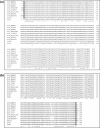Intra-species recombination among strains of the ampelovirus Grapevine leafroll-associated virus 4
- PMID: 31744534
- PMCID: PMC6862812
- DOI: 10.1186/s12985-019-1243-4
Intra-species recombination among strains of the ampelovirus Grapevine leafroll-associated virus 4
Abstract
Background: Grapevine leafroll disease is one of the most economically important viral diseases affecting grape production worldwide. Grapevine leafroll-associated virus 4 (GLRaV-4, genus Ampelovirus, family Closteroviridae) is one of the six GLRaV species documented in grapevines (Vitis spp.). GLRaV-4 is made up of several distinct strains that were previously considered as putative species. Currently known strains of GLRaV-4 stand apart from other GLRaV species in lacking the minor coat protein.
Methods: In this study, the complete genome sequence of three strains of GLRaV-4 from Washington State vineyards was determined using a combination of high-throughput sequencing, Sanger sequencing and RACE. The genome sequence of these three strains was compared with corresponding sequences of GLRaV-4 strains reported from other grapevine-growing regions. Phylogenetic analysis and SimPlot and Recombination Detection Program (RDP) were used to identify putative recombination events among GLRaV-4 strains.
Results: The genome size of GLRaV-4 strain 4 (isolate WAMR-4), strain 5 (isolate WASB-5) and strain 9 (isolate WALA-9) from Washington State vineyards was determined to be 13,824 nucleotides (nt), 13,820 nt, and 13,850 nt, respectively. Multiple sequence alignments showed that a 11-nt sequence (5'-GTAATCTTTTG-3') towards 5' terminus of the 5' non-translated region (NTR) and a 10-nt sequence (5'-ATCCAGGACC-3') towards 3' end of the 3' NTR are conserved among the currently known GLRaV-4 strains. LR-106 isolate of strain 4 and Estellat isolate of strain 6 were identified as recombinants due to putative recombination events involving divergent sequences in the ORF1a from strain 5 and strain Pr.
Conclusion: Genome-wide analyses showed for the first time that recombinantion can occur between distinct strains of GLRaV-4 resulting in the emergence of genetically stable and biologically successful chimeric viruses. Although the origin of recombinant strains of GLRaV-4 remains elusive, intra-species recombination could be playing an important role in shaping genetic diversity and evolution of the virus and modulating the biology and epidemiology of GLRaV-4 strains.
Keywords: Ampelovirus; Grapevine leafroll disease; Grapevine leafroll-associated virus 4.
Conflict of interest statement
The authors declare that they have no competing interests.
Figures



References
-
- Dolja VV, Meng B, Martelli GP. Evolutionary aspects of grapevine virology. In: Meng B, Martelli GP, Golino D, editors. Grapevine viruses: molecular biology, diagnostics and management. Switzerland: Springer, Cham; 2017. pp. 659–688.
-
- Herrbach E, Alliaume A, Prator C, Daane K, Cooper M, Almeida R. Vector transmission of grapevine leafroll-associated viruses. In: Meng B, Martelli GP, Golino D, editors. Grapevine viruses: molecular biology, diagnostics and management. Switzerland: Springer, Scham; 2017. pp. 483–503.
Publication types
MeSH terms
Substances
LinkOut - more resources
Full Text Sources
Research Materials
Miscellaneous

